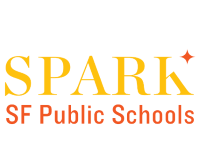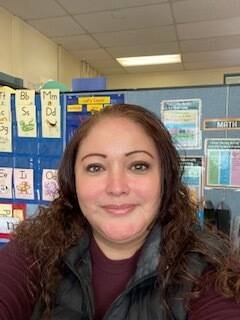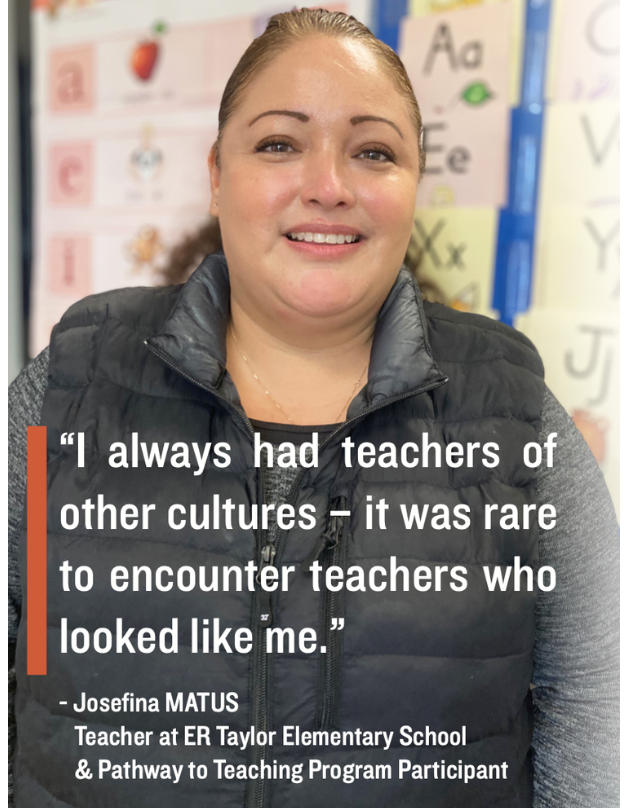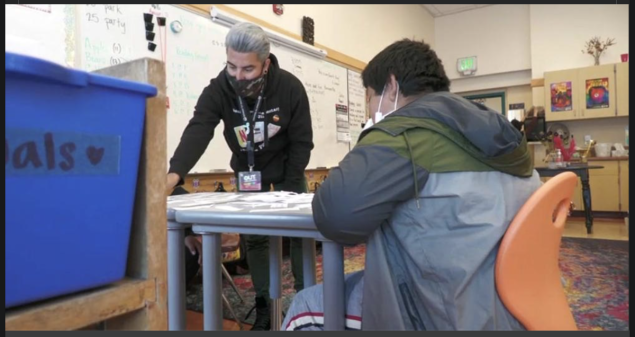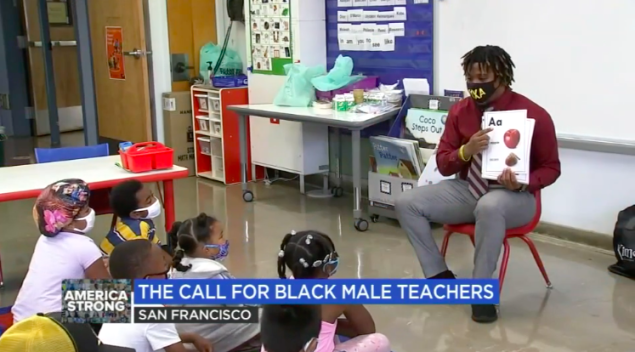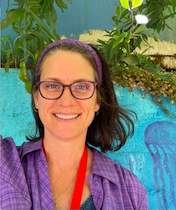Pathway Alumnx News Highlights Link to this section
Pathway in the News
Link to this section
Creating a Diverse Teacher Pipeline at SFUSD - June 2023
Creating a Diverse Teacher Pipeline at SFUSD
June 2023 | Spark SF Public Schools
With support from Spark SF Public Schools through the Crankstart Foundation, SFUSD’s Pathway to Teaching program, the district’s own internal teacher credential program, kicked off its Pre-Service Preparation (PSP) program on June 5th at Buena Vista Horace Mann School, welcoming its 7th cohort of teacher candidates. The Pathway teacher candidates -- who are over 75% teachers of color -- are immersed in learning to teach over 250 SFUSD K-5 students this summer in preparation for teaching in their own SFUSD classrooms in August.
Pathway to Teaching’s innovative teacher preparation model provides candidates a rich and rigorous summer field experience and coursework so that teacher candidates are day-1 ready for their classrooms in August. Each day during the first six weeks of PSP, Pathway teachers are in classrooms with students engaged in modeling, teaching, real-time coaching, and rehearsals for teaching under the supervision of an expert SFUSD Teacher Educator.
Many of the Teacher Educators earned their credential through Pathway to Teaching, bringing the experience full circle. Gabrielle Milleza, who has five years of experience as a Teacher Educator with Pathway to Teaching and is a National Board certified teacher, says about the experience, “As a Teacher Educator this program is a great way for me to reflect upon my teaching and grow as a teacher, while also coaching our Pathway teachers to set them up for success with that immediate feedback and support that they wouldn’t get in another teacher prep program.” Gabrielle has found her years of summer experience so enriching that she is going to be joining Pathway's school year coaching team this fall.
Pathway to Teaching’s PSP is made possible through a collaboration with Jamestown Community Center and Buena Vista Horace Mann School to create a full-day summer program for students from the Mission. During PSP, students participate in three and a half hours of instruction in math and literacy with Pathway teachers, followed by an afternoon of activities led by the Jamestown team.
In the afternoons, Pathway teachers engage in a learning lab with their Teacher Educator to reflect on their instruction and student work and learning, plus they plan for and rehearse the next day’s instruction. Teachers also attend coursework at the end of the day, as well as before and after PSP. After eight weeks of PSP, Pathway teachers become interns and start a full year of coaching, coursework, and teaching as they work towards their preliminary teaching credential in one of the following areas: Multiple Subject, Multiple Subject + Bilingual Spanish Authorization, or Education Specialist Mild to Moderate Support Needs.
Since 2017, Pathway has prepared over 300 teachers to teach in SFUSD schools. Pathway teachers represent 36% of all Special Education Mild to Moderate teachers and 20% of all Multiple Subject Bilingual Spanish teachers in SFUSD.
SFUSD recruits record number of internal candidates to teach in classroom - Dec. 22, 2022
SFUSD recruits record number of internal candidates to teach in classroom
Allyson Aleksey | Dec 20, 2022 | SF Examiner
The teaching profession is a calling for some, and costly for most. San Francisco Unified’s Pathway to Teaching program, which began in the 2017-18 academic year, has aimed to lower the cost and time barriers to become a credentialed teacher. This year, the program pulled from its own staff of substitute teachers, paraeducators and those with “emergency credentials,” or a provisional waiver to teach, to recruit a record number of internal applicants.
To date, the program has graduated 276 teachers who are now employed at SFUSD; this year the program received 94 applications.
The National Education Association reported in 2021 that half of all educators took out student loans to pay for college, and owe $58,700 on average. One in seven still owes more than $105,000. Factor in credential coursework, fees for enrollment, exams and textbooks and costs could reach an additional $15,000.
“Nationally, we see a lot of barriers to accessing a teaching credential. In California, we see this exacerbated by the cost of living,” said Kristin Alvarez, program supervisor for Pathway to Teaching.
Alvarez underscored the importance of having multiple entry points to the credential. The traditional model for prospective teachers is an undergraduate or graduate program, with coursework in pedagogy and educational instruction areas and field experience through student teaching.
“That is quite a bit of time to access (that credential) — a multi-year endeavor with tuition associated,” Alvarez said.
For those switching careers to enter the teaching profession, the hurdles are higher. Many cannot afford to step away from a paid position to pursue a teaching credential, Alvarez said.
By comparison, the Pathway program costs $5,000 via 10 payroll deductions, and teachers can earn their preliminary credential in as little as 15 months. While teaching full-time in the classroom, candidates earn full-time teaching salaries and benefits.
San Francisco and other public school districts are grappling with teacher shortages, resignations and high attrition; according to SFUSD, teacher attrition has held steady at 10% each year for a decade. Pathway to Teaching, now in its sixth year, was created in response to teacher shortages in hard-to-fill subject areas.
“We know that the key to student success in any classroom is a consistent, highly-skilled and qualified teacher,” superintendent Matt Wayne said in a statement. “We’re excited that our Pathway to Teaching program offers staff members the opportunity to become credentialed teachers.”
A goal of the program is to foster a diverse cohort of teachers who are likely to remain teaching within the district. This year, 80% of the Pathway cohort identifies as a person of color. And among Pathway graduates now teaching in the district, 68% identify as a person of color.
The cohort is also diverse in its teaching experience. Some hold undergraduate degrees and have worked with youth in educational settings or have already served as substitute teachers or paraprofessionals. Others have changed careers altogether, but once graduated aren’t considered novice, first-year teachers, Alvarez noted. Candidates graduate with in-field, in-classroom experience, unlike some education programs.
“This is a fast-start intern program,” she said. “(Candidates) do approximately two semesters of work with us before they become a teacher of record, which includes field work and course work, but they are then a first-year teacher concurrently as they are earning the remainder of their credential requirements.”
Before the academic year begins, Pathway teachers complete spring “launch” coursework and fieldwork in the summer. Throughout the school year, they continue coursework and receive coaching from education professionals in the district.
“Our coaches during the academic year are in classrooms every week with our candidates. A real cornerstone of our program is ‘real-time coaching.’ We’re really trying to build that muscle memory to ensure candidates know what to say as they are actually enacting teaching. We don’t believe in (coaches) just sitting in the back of the classroom and taking notes,” Alvarez said.
Alvarez assumed the supervisor position in 2018. Over the past four years, under her tenure, Pathway to Teaching has prepared 276 teachers for classroom instruction at SFUSD: this includes 155 special education teachers, 60 multiple subject elementary-level teachers and 61 bilingual Spanish teachers.
The retention rate for Pathway graduates is high — 94% return for a second year, and 84% for a third. Not bad for a profession that has been decimated by COVID. According to the National Center for Education Statistics, nearly one-quarter of teachers said they want to leave the profession altogether, compared to the pre-pandemic national turnover rate of 16%.
“Nationally, the climate to attract teachers is not great right now. It is a tough time to become a teacher, or for teaching to be appealing,” Alvarez said.
She recalled the previous summer program working with Pathway candidates, watching her soon-to-be educators monitoring students during recess.
“I just had this moment ... and thought, it is awe-inspiring to see people still want to become teachers, almost in spite of this national negative narrative around teaching. It’s incredibly inspiring to me to see so many people so motivated to work with young people,” she said.
Usually, about 30% of Pathway candidates are internal to SFUSD — the fact that this year has doubled is promising.
“That tells me we are doing a good job of cultivating our internal talent, and increasing access for the next step in someone’s career,” Alvarez said.
Investing in New Teachers - May 2022
How to Instill a 'Growth Mindset' in Kids - April 14, 2022
How to Instill a 'Growth Mindset' in Kids
Gail Cornwall | April 14, 2022 | USNews
Teachers and parents can help kids develop a mindset for success, but expert advice on how to do so is essential.
As K-12 schools increasingly recognize the importance of social-emotional learning, many schools are trying to help kids cultivate a “growth mindset.” What does that mean?
According to Carol Dweck, the Stanford University professor who coined the phrase, having a growth mindset means believing that your basic qualities – like how smart you are or whether you’re good at math – are things you can change, through your own efforts and help from others. In her pathbreaking 2006 book “Mindset: The New Psychology of Success,” Dweck contrasted this with a “fixed” mindset, which is best summed up as “you have it or you don’t.”
The difference matters. Research has shown that kids with a growth mindset embrace challenges, persist in the face of setbacks and learn from their mistakes. They feel a greater sense of control over their lives and become more motivated. All of that translates to an academic impact: For instance, one 2021 report from the Program for International Student Assessment (PISA) found that students identified as having a strong growth mindset scored significantly higher on all subjects than those who believed their intelligence was fixed.
Dweck and other researchers have found that simply teaching kids about growth mindset can help them develop it, and that can have a direct impact on their achievement. Schools have taken note and attempted to help kids see effort as the path to ability. But several common missteps have been identified over the years.
What Schools Teach About Growth Mindset vs. Fixed Mindset
If you believe that intelligence, skill and strength are fixed, then every test, every project and every sporting event feels like an invitation to prove your greatness or reveal your deficiency. There’s no third option. With a fixed mindset, if you have to work hard, it means you’re not smart. You can’t admit to a misstep, let alone learn from it. The worry about being found lacking is constant. These kids, says Laura Markham, author of “Peaceful Parent, Happy Kids,” “would rather [you] think they’re smart, but just not trying, than think they’re not smart.”
With a growth mindset, kids see the goal as development, not perfection, and can ditch this binary thinking, says Kristin Smith Alvarez, who has seen growth mindset coaching in action in dozens of schools as a teacher educator in the San Francisco Unified School District. When teachers cultivate a “culture of error,” she says, with “that tone in the room of, ‘We are here to make mistakes as learners,’” kids who face setbacks say things like, “I don’t know it … yet' and ‘I’m a work in progress.’”
How Adults Can Help Kids Develop Growth Mindset
We all slip in and out of the two mindsets. To help kids get in a growth mindset more of the time, Sean Talamas, the executive director of Character Lab, a nonprofit that connects researchers and educators to improve students' well-being, says in some ways, “It’s probably easier to think about the things you should try to avoid than the things to do.”
The first no-no seems unrelated: Don’t be overbearing. Experiments show that when adults step in to take over a challenging task, kids are more likely to give up sooner on the next one. Why? If you swoop in to help, you imply they’re not capable.
Parents often send hidden messages like this. “Without realizing it, we evaluate kids constantly,” Markham says. Even if it’s positive – e.g., “you’re a natural” or “you’re so smart” – our assessment transmits a fixed mindset. Alvarez says compliments should avoid communicating, “You have fixed traits that I like” and instead commend specific aspects of performance, with a focus on hard work, practice, problem solving and persistence.
When kids whiz through a task, she recommends saying, “Let’s get you some problems that will challenge you so you can continue to build and get stronger!”
Modeling is essential. Alvarez recently watched a teacher realize she’d made a phonics error in front of the class. “She used it as an opportunity to say, ‘Look, I made a mistake here. We are all learning and growing.’” At home, parents can do the same by sharing stories about setbacks at work and saying things like, “I’m not great at navigating Snapchat yet, because I haven’t put time into learning the features.”
Growth Mindset Activities
Beyond shifting their own behavior, teachers and other adults can try a few kid-friendly activities.
Read kids stories about characters learning from failure and persisting through challenges, like "Rosie Revere, Engineer," suggests Markham. Tell them stumbling is part of the learning process. Markham says to let kids know they’re supposed to feel challenged, and it’s OK to be uncomfortable. The goal is to eschew what Character Lab calls “the myth of the lazy genius” and glamorize striving instead.
Alvarez agrees that the trick is making challenge desirable. Make sure kids know that another student’s work product is like an island that’s the top of an underwater mountain, she says. Ask them what invisible effort could have gone into a peer’s achievement to help kids avoid thinking of others as naturally more talented. It loops them back to “yet,” she says: “It’s a simple three-letter word, but it really does shift that power of possibility and interrupts the narrative of ‘I’m not good at it.’”
In one study, supported by Character Lab, ninth graders who spent 15-20 minutes writing about a failure and how it changed them for the better – or a success story and what they did to make it happen – demonstrated greater academic persistence and got better grades. The effect lasted for weeks before fading. Alvarez says even young kids can engage in this sort of reflection exercise to get a persistence and resilience boost.
Common Pitfalls of Growth Mindset
But watch out for a few ways growth mindset coaching can go wrong.
First, you can’t fake it. Alvarez says she’ll have elementary educators come in who believe deeply in the concept of growth mindset for their students, but then say, “I’m not a math person.” Markham sees the same thing in the way parents talk about themselves: “I messed that up” or “I’m just not good at tennis.”
“Parents and educators that don’t themselves have a growth mindset but are trying to follow a script to try and promote it, I think can be … more harmful than helpful,” Talamas says.
And it’s easy to miss the mark on the “hard work” piece. Parents sometimes say, “You worked so hard” when the kid didn’t.
Another thing to keep in mind is that there are limits to how much hard work is healthy. Researchers warn that growth mindset messaging can contribute to “grind culture” in high-achieving schools. Talamas makes a related point: Kids often need to stop and try a different tack, and they should be encouraged to ask for input when needed. Markham says, “This is where it’s an art and not a science.” Let them problem-solve and build up a frustration tolerance, but provide enough support so they don’t get to “the point where they throw it across the room,” she says.
J. Luke Wood, a professor of education at San Diego State University, says growth mindset assumes that children have a baseline level of confidence in their ability, “and what you find is that with students of color, many of them have never heard someone say, ‘You are intelligent, you are capable.’” In fact, the reverse may be true. They don’t see themselves reflected in positions of power in the wider world the way white children do. And in schools, Wood’s ongoing research confirms what other studies have long established: Black students are forced to grapple with an assumption of academic inferiority. Knowing this, he says, “You can validate the effort that they put in, their perseverance, but you also have to give them that life-giving message” that they are capable.
Wood says parents and educators should aim for a combo-message – expressing faith in children’s effort and their ability – with any student who may feel marginalized, including kids with disabilities, English-language learners and girls in STEM classes.
Finally, context is important, especially for disadvantaged students. Growth mindset coaching can send the message, “If you haven’t done as well, it’s because you haven’t worked as hard,” Wood says. But some kids have more resources and support systems than others. And there isn’t equity in the opportunity to work hard academically when some kids have to commute two hours to school, work a job or take care of siblings. Wood sees a danger of sending “a myth-of-meritocracy, bootstrapping message.”
Navigating these concerns is easier if adults also embrace a growth mindset. Think of stumbles in your own messaging as opportunities to grow. If you keep at it, pretty soon you’ll have kids who react to a challenge that way, too.
Equity in the Classroom: Black teacher in SF's Bayview inspiring students, diversifying industry - Sep. 13, 2021
Lyanne Melendez | September 13, 2021| ABC 7 News
(Watch the interview video on the bottom section of this webpage)
SAN FRANCISCO (KGO) -- In the last 18 months, America has endured a health crisis unseen in our lifetime. Our kids were away from the classroom and many people lost their jobs. Still, we like to think that we are strong as individuals, as communities and as a nation. There are two recruiting programs that are helping to build equity among teachers to make America even stronger.
That's how we met Mr. C.
"As I approach the school it's like how can I impact these students today," he asks himself. "Everyday is going to be different and that's what I love about teaching."
RELATED: Bay Area schools providing free, remote 24/7 tutoring for students
Recent Stories from ABC 7 News
San Francisco tourism industry bracing for boost as US lifts international travel restrictions
"Good morning!" he greets the staff at his school. "Good morning Mr. C!"
Mr. C is short for Codion Isom, a kindergarten teacher at Malcolm X Academy in San Francisco's Bayview District.
"Alright class, let's make sure we find a spot on the carpet, " he instructs his class.
He's only 28-years-old yet when we sat down with him, Mr. C delivered a thought-provoking question.
"Can you name or remember how many Black male teachers you had?" he asked ABC7's Lyanne Melendez.
She couldn't remember a single one.
Inside the classroom he is an engaging teacher. "A is for apple, A, A, Apple," his students respond enthusiastically.
These kids will always remember that their first teacher was an African American male.
"The good in having it is like now I have someone in front of me who knows what I'm going through, who's probably been through what I've been through," expressed Mr. C.
His mom died when he was only 5 and he never knew his father. He was raised by his grandparents in Michigan.
"My grandmother always told me Cody, you're going to work with kids," he said with a big smile.
"The teaching population as we know nationally is not incredibly diverse, it's still incredibly white, it's still incredibly female," said Kristin Smith Alvarez who heads the San Francisco Unified School District's recruiting program called Pathway to Teaching.
That's the case across this country where more than half of schools don't have a black teacher and less than 2% of schools have a Black male educator.
But programs like Pathway to Teaching and Urban Ed Academy are helping to build equity in education by recruiting Black and Brown male teachers.
"Research tells us that the impact of having, for example, a Black teacher on Black students is profoundly positive in terms of the impact there not only for Black students but for students of all races," added Smith Alvarez.
"Seeing that they're accepting us by putting us into these classrooms, they are saying we believe in you, we know the change that you can be, it's just inspiring," said Mr. C.
Can School Districts Be Education Schools, Too? - Oct. 14, 2020
Can School Districts Be Education Schools, Too?
Dan Weisberg | October 14, 2020 | TNTP
Teachers are the most important part of any school’s success—yet many school systems struggle year after year to find the teachers they need to staff their classrooms. The problem isn’t so much an overall teacher shortage as a shortage of the right teachers in the right subjects. For example, education schools might graduate lots of elementary teachers when local schools might really need special education and high school STEM teachers. And since teachers produced by most traditional preparation programs are overwhelmingly white, almost any district looking to increase teacher diversity—which can dramatically increase opportunities for students of color—will struggle to find enough teachers of color.
School systems can address some of these challenges by partnering more closely with local teacher preparation programs—for example, by sharing projections for the number of teachers they’ll need in different license areas well in advance. But what if districts didn’t have to rely solely on outside providers to find and train the teachers they need?
It’s an idea we’ve been exploring since 2015 with funding from U.S. Department of Education’s Supporting Effective Educator Development (SEED) program. We’ve helped school systems in several cities—including Boston, Charlotte, Dallas, San Francisco, and Tulsa—create in-house alternative certification programs based on our successful Teaching Fellows model. As we worked closely with our partners to get the programs up and running, we also planned to transition full ownership to district staff within 2-3 years—ensuring the programs would be sustainable for the long run and not dependent on outside partnerships.
We knew district-run teacher training programs had a lot of upside: for example, districts could customize everything from selection criteria to pre-service training to fit their priorities, expectations, and specific staffing needs from year to year. But because few districts have ever tried this approach, we couldn’t be sure it would work in practice. And we heard skepticism from some observers about whether districts really had the ability to pull this off.
Fortunately, we now have an answer. Last month, the RAND Corporation released results from a study of three of the programs we’ve helped develop. The findings show that in-house certification programs can be a valuable part of any district’s teacher pipeline. Specifically, RAND found that:
- Teachers trained by the programs contributed substantially to the teacher supply in these districts, particularly in hard-to-staff subject areas.
- The programs trained teachers who were more racially diverse than those who came from other sources.
- Teachers certified by the programs were significantly more effective than other first-year teachers in math, at least as effective in English, and just as likely to remain in teaching.
Taken together, the findings about diversity and effectiveness are especially important: they’re the latest proof that we don’t have to choose between high expectations for the teaching profession and a teacher workforce that actually looks like the students it serves. If a startup teacher preparation program can achieve these results, there’s no reason established education schools with access to multi-billion dollar endowments can’t do the same.
While we don’t yet know exactly how the COVID-19 pandemic and its economic aftermath will affect school staffing, it’s safe to say they won’t make things any easier. Now more than ever, federal and state governments should look for ways to support innovative approaches to teacher preparation—including district-run programs.
Pathway Teacher Codion Isom + Man The Bay - Sep. 17, 2020
How the Warriors are working to get more Black men teaching in San Francisco’s classrooms
Wes Goldberg | September 17, 2020 | East Bay Times
Codion Isom, a product of Urban Ed program in Bayview supported by Golden State Warriors, is in his first year teaching at Malcolm X Academy.
To get the students’ attention, the San Francisco teacher turned to someone familiar: Stephen Curry. Well, not the real Curry, but the idea of him.
During a recent virtual class for Malcolm X Academy, a predominately Black elementary school in San Francisco’s Bayview neighborhood, Codion Isom asked his group of kindergarteners if they knew which Warriors player was 32 years old, 6-foot-3 and married to Ayesha. Referencing Warriors players is one of the ways the first-year teacher is able to hold his students’ attention.
“‘Can you tell me what player that is?’” Isom recalled asking. “And some of the kids are like, ‘That’s Stephen Curry! That’s Stephen Curry!’ We’re always talking about them in the classroom.”
Isom, 27, is a product of the “Man The Bay” teacher development program from Urban Ed Academy, a San Francisco-based organization that aims to increase the representation of Black and Latino educators in classrooms. Since 2014, the Warriors Community Foundation has granted more than $300,000 to the program.
“Representation matters,” said Urban Ed’s executive director Randy Seriguchi. “You need to be able to see somebody that looks like you and, even across the screen, that’s great.”
Today, Black men make up less than less than 2% of America’s teaching force and Latino men make up less than 3%, according to Urban Ed. Through the “Man The Bay” program, the organization works with Black homeowners in the Bayview area to help renovate their homes in exchange for housing prospective teachers at an affordable rate. Urban Ed then provides “fellows” like Isom with training, housing and mentorship.
Because of his experience working at his local YMCA in his hometown of Detroit, Isom knew after earning his degree from Texas Southern University a little more than a year ago, he could make an impact by working with children.
As classes resume virtually during the coronavirus pandemic, teachers are challenged to keep students engaged and make the personal connections that happen in the classroom.
“It’s been pretty difficult but the thing that I do is I’m making sure we’re always having fun,” Isom said, referring to his name-that-Warrior game. “Sitting in front of the screen can be distracting and disengaging, so we play different games.”
Before these social-distancing times, Warriors players visited Malcolm X Academy, making them a bit more than just Jeopardy!-style answers to the students.
In 2018, the first year of the partnership between the school and the Warriors Community Foundation, former Warriors center DeMarcus Cousins visited the school. Instead of a quick pop-in, Cousins stayed the entire afternoon and played basketball with the kids.
“He appreciated that this was a Black organization of Black students in a Black neighborhood,” Seriguchi said. During Cousins’ visit, a local news crew caught the 7-footer blocking a student’s shot. The clip went viral. “The kid loved it, ate it all up,” Seriguchi recalled.
As president of the Warriors Community Foundation, Nicole Lacob — the wife of Warriors majority owner Joe Lacob — aimed to address the achievement gap among communities in the Bay Area. She homed in on Bayview — a neighborhood with the city’s highest Black population (21.5%, according to the 2010 U.S. Census) and had a high-school graduation rate of just 23% when the partnership started six years ago.
“We really thought we’d invest our money specifically there so that we could move that needle,” Nicole Lacob said.
This year, the first wave of teachers from Urban Ed will be hired into classroom jobs. Three, including Isom, have already been hired as teachers, and two more are expected to complete the program, which would mark a 100% success rate.
Going forward, the partnership between the Warriors and Urban Ed will continue to focus on addressing the racial divide, housing crisis and achievement gap in Bayview.
When teachers are allowed back into classrooms and fans back into Chase Center, Isom — who still has his wristband from the time he and his fellows at Urban Ed sat courtside for a game — hopes to meet Draymond Green and tell Green about the time he watched the fellow Michigan native play his school in a basketball game.
Until then, which Warriors player is 30 years old, 6-foot-6 and from Saginaw, Michigan?
“It’s about getting their attention,” Isom said of his game. “But it’s also teaching them a lesson, as far as being aware of their surroundings.”
RAND Research Finds Positive Impacts of Pathway to Teaching - Oct. 2020
RAND Research Finds Positive Impacts of Pathway to Teaching
TNTP, an organization committed to ending educational inequities by promoting the recruitment, training, and retention of high-quality teachers and school leaders, implemented its Teacher Effectiveness and Certification (TEACh) initiative in three urban school districts. Through TEACh, TNTP works with school districts to develop a within-district process to recruit, prepare, and certify teacher candidates, as well as hire and support them in their first year. As part of an evaluation of this initiative, RAND investigated each district program's implementation and costs, the effects of TEACh on the recruitment and retention of teachers, and the relative performance of those teachers. This is the final report for that evaluation.
Key Findings
Communication was vital to the implementation of TEACh
- Transparent and effective communication between the TEACh program staff and teaching candidates defined participants' experiences in the program.
- Collaboration between TNTP and district staff was key to ensuring that the TEACh program served its purpose but also fit with districts' diverse needs and infrastructure.
The impact of TEACh was clearest in its supply of racially diverse teachers for hard-to-staff district roles
- The TEACh program contributed substantially to the supply of teachers in participating districts, particularly in hard-to-staff roles. TEACh teachers were also more racially diverse. They remained teaching in the district at rates comparable to those of other new teachers.
- Achievement gains in mathematics were significantly higher for students of TEACh teacher candidates in their first year, relative to students of comparison first-year teachers, in each district. In English Language Arts (ELA), first-year results were directionally positive but not statistically significant.
The cost of TEACh was somewhat higher than that of similar programs, but the costs of various components in different districts varied widely
- In its first three years, the average cost per TEACh hire was somewhat higher than available estimates for similar programs operating within or with school districts. However, the range of TEACh costs varied widely across the three districts and likely included large start-up costs.
- Major TEACh program costs included the costs for district and TNTP staff and the costs for pre-service training and coaching, in particular.
Pathway Teacher, Nicole Phillips Wins RAVE - Aug 2021
Nicole Phillips, Teacher, Glen Park Elementary School - Special Service Award for August 2021
Websource | SFUSD
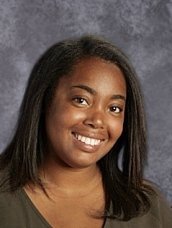
"Ms. Phillips is amazing and has greatly exceeded my expectations (as a parent of a first-grader) about distance learning. She is a master of her craft. She has so many strategies for engaging students via Zoom- constantly making it very clear what she expects them to do, ways for them to physically show that they are engaged, and offering positive re-enforcement. She has high expectations and provides lots of support- in her instruction, assignments, and feedback. She provides video feedback on assignments that is supportive while pushing students to do more. I am constantly impressed by Ms. Phillips and feel lucky that our child has her as a teacher."-Nominated 9/2020 and 10/2020.
Pathway Teacher, Matthew Hernandez Nominated for RAVE 2020 - Nov. 2020
RAVE Nominee
Individual
11/16/2020 13:04:03
Tenure: 2 years
Websource | SFUSD
Name: Matthew Hernandez
Department/School: Monroe Elementary School
Title: Teacher
Why are you nominating this employee?
Mr. Hernandez is an excellent teacher.
What are some of the positive qualities that distinguish this employee’s work?
He is friendly and responsible.
Please give us a specific example of something that this employee did/does that you
would like to recognize:
Mr. Hernandez is a great and excellent teacher. He maintains a highly professional approach
for students. He is kind, responsible, compassionate, efficient, patient, and an excellent
communicator. He has so many strategies for engaging students via zoom-constantly making it very clear what he expects them to do. He has high expectations and provides lots of support. The environment he creates for the students is also very joyful and relaxing during distance learning period. I'm nominating Matthew Hernandez for the Rave because he is creative, dynamic, hard-working with the students.
Nominated By: Colleague
Pathway Teacher Educator, Yasmir Navas 2020 RAVE Winner - Oct. 2020
Yasmir Navas, Special Education Teacher, Sanchez Elementary School - Distinguished Service Award Winner for October 2020
Websource | SFUSD
"Yasmir views every opportunity and challenge through the lens of student need. With the lens of a SpEd educator, she advocates in all settings (classrooms, staff meetings, assemblies, field trips) for accessibility and inclusion for ALL students. Yasmir views every student in the school as her own student. She opens her doors to students who need a break or a snack- students prefer her classroom because it is so warm, so friendly, so multi-sensory and so relationship-driven. Yasmir's tireless push for inclusion of her students in General Education settings both academically and socially makes Sanchez overall a better and more community-oriented place to be "-Nominated 1/2020
Pathway Special Education Teacher Sabrina Belara at Balboa High School Wins Rave Award - Oct. 8, 2019
Pathway Special Education Teacher Sabrina Belara at Balboa High School Wins Rave Award
October 8, 2019
Sabrina Belara joined the Balboa HS faculty through the new Pathways program that helps fast-track special education educators to be full-time, certificated educators within SFUSD. According to those who nominated her, Sabrina proved herself to be diversity-driven and a true asset to Balboa’s team with her 1-on-1 coaching of bilingual students. She mentors those who seek input and support, she’s constantly communicating with her students' parents, and is always ready to learn and challenge herself to be the best and most organized case manager that she can be.
Learn more about Sabrina Belara and check out our other RAVE winners and nominees who model the core values we are all RAVE-ing about.
SFUSD's Teacher Credential Program Incorporates Digital Instruction - Jul. 21, 2020
SFUSD's Teacher Credential Program Incorporates Digital Instruction
July 21, 2020 | SFUSD
San Francisco (July 21, 2020) - At a time when the San Francisco Unified School District (SFUSD) is offering support for educators to teach students from a distance during the COVID-19 pandemic, the district is also preparing future educators enrolled in SFUSD’s Pathway to Teaching program on how to teach virtually.
The 74 participants in this year’s cohort of Pathway to Teaching, a credentialing program run by SFUSD that allows teacher candidates to earn their teaching credential while getting paid to work as a teacher, are finishing their seven weeks of coursework and applied practice and are preparing to lead classroom instruction virtually when the 2020-21 school year begins in August.
SFUSD Pathway to Teaching is a teacher credentialing program approved through the California Commission on Teacher Credentialing. Now in its fourth year, the program begins with a seven-week intensive summer teacher preparation program. Then, throughout the school year, the teachers complete courses and work with a Pathway coach for 1-2 hours a week. The coach helps them plan lessons, observes their classroom instruction, either in person or online, and provides them with real-time feedback to quickly develop their teaching. By the end of the school year, teachers can earn a preliminary credential in Multiple Subjects, Bilingual Spanish, or Special Education.
Pathway to Teaching incorporates an anti-racist teaching lens and helps to remove barriers for those who want to become a teacher: over 69% of the cohort are people of color, and over 90% are local to the Bay Area.
“As an elementary school teacher myself, I know that being an educator is one of the most rewarding careers a person can have. SFUSD’s educator preparation program is helping SFUSD prepare educators who we hope will stay in the district and grow as professionals throughout their careers,” Board of Education President Mark Sanchez said.
In the summer program, the courses and daily lab focused on particular aspects of teaching, such as creating safe and supportive classrooms, effective lesson planning, creating a robust literacy classroom, and universal design for learning. In past years, the courses and labs were taught at a school with summer programming so the teacher candidates would have an opportunity to practice their teaching in a classroom with students.
For the first time the summer classes and labs were all held virtually via Zoom. In the virtual environment, Pathway is utilizing its learning lab structure, in which small groups of Pathway teacher candidates are grouped with expert, veteran SFUSD teachers to practice teaching in a virtual classroom and simulate being teachers and students. This opportunity allows the teacher candidates to gain valuable practice that translates to both in-person teaching and the distance learning environment. It’s also a teacher leadership opportunity for the expert teachers who staff the program.
Participants receive instruction on how to teach virtually. Pathway teacher candidates are learning how to teach with programs such as Zoom, Google Classroom, Jamboard, and Padlet. The teachers are gaining practice in how to use these tools so they can be as prepared as possible for distance learning, hybrid instruction, or face-to-face teaching.
”Just as we aim to prepare our graduates for an ever changing world, we must prepare our teachers for the same. With Pathway to Teaching our diverse educator candidates are developing skills to teach remotely and in-person,” Superintendent Dr. Vincent Matthews said.
School Superintendent Vincent Matthews: How to Become a Teacher - Jan. 30, 2019
School Superintendent Vincent Matthews: How to Become a Teacher
Vincent Matthews | January 30, 2019 | Examiner
San Francisco Examiner article
When I was a teacher at Dr. George Washington Carver Elementary School, I loved going to work every day because I knew I was making a difference in the lives of the young people who showed up each day. Now I have the wonderful opportunity to hear from teachers about why they love their job.
One educator recently explained that she went into teaching because, as a Spanish speaker and the first person in her family to go to college, she wants to be someone that her students can relate to. Another educator said that he’s inspired by the funny, smart, deep and thoughtful nature of the children who surround him every day.
If these sound like great experiences to you, you’re in luck. We are actively recruiting for programs that help people become SFUSD teachers, and it’s not too late to apply for the 2019-2020 school year. In fact, our very own Pathway to Teaching — the first district-sponsored teacher credentialing program — is taking applications from those interested in teaching Bilingual Spanish or Special Education through February 18.
There are a number of ways to pursue a career in education here in San Francisco. We deeply value teacher candidates who come from traditional preparation programs, but we are also seeking talented people from diverse backgrounds and experiences who are motivated to unleash our students’ potential.
Pathway to Teaching is a one-year program where participants earn their credential while teaching in a classroom. This program is well-suited for those who have experience working with children and youth (e.g., paraprofessional, substitute teacher or after school service provider) and want to become a credentialed teacher. Participants receive intensive training and regular coaching from an experienced teacher coach, lead their own classrooms, and complete online and in-person coursework. These new teachers earn a salary while they work toward their preliminary credential. We are primarily recruiting elementary Bilingual Spanish teachers and K-12 Mild-Moderate Special Education (Education Specialist) teachers for this program.
The San Francisco Teacher Residency (SFTR) is a university-union-district partnership where candidates experience a year-long classroom apprenticeship with targeted master’s-level coursework. Participants get hands-on experience in the classroom under the guidance of a master teacher and receive ongoing support essential for successful careers in teaching. Upon completing their residency, successful candidates earn a preliminary teaching credential, master’s degree and a position in an SFUSD classroom.
The New York University Steinhardt Teacher Residency combines a full-year teaching residency under the guidance of an SFUSD teaching mentor with a master’s degree program taught online by NYU faculty and in-person coaching. Residents are paid during their residency year. Like SFTR, this program leads to a master’s degree, preliminary teaching credential and position in an SFUSD classroom. This program focuses on teaching in middle and high schools.
Not sure if you want to teach but want to check it out? Those who have experience with youth or have considered teaching as a profession may want to consider substitute teaching or becoming a paraprofessional, both of which are excellent opportunities to get a foot in the door for future employment with SFUSD.
To uphold our mission of providing each and every student with the quality instruction and equitable support they need to thrive in the 21st century, we look for candidates who are strong collaborators, skilled communicators and problem-solvers, and who are comfortable in a community of continuous learning. After joining the SFUSD community, teachers continue to receive support and professional learning opportunities, regardless of how long they’ve been teaching.
To learn more about these career pathways or apply for open positions, visit www.sfusdjobs.org.
Vincent Matthews is the superintendent of schools for the San Francisco Unified School District. He is a guest columnist.
SFUSD Recruits Potential Bilingual Spanish Educators for Innovative Teaching Credential Program - Jan. 30, 2018
SFUSD Recruits Potential Bilingual Spanish Educators for Innovative Teaching Credential Program
January 30, 2018 | SFUSD.EDU
As a diversity driven district, the San Francisco Unified School District (SFUSD) is recruiting for the second year of Pathway for Teaching program, focusing on training Bilingual Spanish and Special Education teachers for the city’s highest-need schools and subject areas.
Now accepting applications and nominations, SFUSD Pathway to Teaching program aims to recruit community members who wish to become a teacher, but who might not have the flexibility to leave their current job for retraining without financial support. The one-year credentialing program is designed to be affordable and accessible, allowing new teachers to earn a full salary as they earn their credential.
“In our first year, we saw a lot of interest from individuals who are already working in our school communities as paraprofessionals, substitute teachers, or after-school service providers,” Brent Stephens, Chief Academic Officer for SFUSD, says. “This year we’re hoping to build and expand on our local talent. We encourage applications from people in our community who are committed to providing culturally and linguistically relevant learning experiences for our San Francisco students.”
Applicants who pass the selection process will participate in an intensive training program next spring and summer. Beginning next school year, these new teachers will lead their own classrooms with coaching from an expert teacher and extensive coursework. At the end of the school year, those who demonstrate success in the classroom will be recommended for their preliminary teaching credential, continue working in SFUSD and complete two more years of formal induction coaching and support.
“Pathway has given me a beautiful experience with my class,” said Bilingual Pathway teacher Stephanie Suarez. “As I learn with them I am also comprehending why we do certain tasks. Seeing my students grow as well as seeing my cohort grow as teachers has been the greatest motivation! “
Last year, the program’s inaugural year, Pathway for Teaching exceeded its goal of recruiting diverse teachers who mirror the diversity of the communities they serve. Almost half the teachers trained were teachers of color—including 33 percent who identified as Latino.
SFUSD to Provide Pathway to Teaching Credentials - Dec. 19, 2016
SFUSD to Provide Pathway to Teaching Credentials
Jill Tucker | December 19, 2016 | SFGate
Hoping to make it easier, faster and cheaper to become a teacher, the San Francisco school district is going into the teacher-credentialing business, offering courses and training typically administered on a college campus.
Only a handful of districts across the state have internal credentialing programs, in which staff do the teaching instead of college professors. Los Angeles and Mount Diablo, in Contra Costa County, are among the few. Such programs require state authorization from the California Commission on Teacher Credentialing.
In San Francisco, the goal is to recruit, train, credential and hire teachers, district officials said, in a bid to alleviate an ongoing teacher shortage and ensure that those hired are specifically prepared to teach in city schools.
“We’re going to tailor that preparation so that these folks are as prepared as possible for these (job) opportunities,” said Chris Canelake, the district’s executive director of professional learning and leadership.
“Since we have connections with these folks, we’re able to recruit them directly and offer them an alternative that might for many people get them past some of the barriers they might find when they’re trying to get their teaching credential,” he said. “We’re also recruiting people who really reflect the community.”
District officials hope about 50 to 75 new teachers will go through the Pathway to Teaching program in the next year.
“We need the SFUSD Pathway as another option for aspiring teachers to get their credential,” said Brent Stephens, the district’s chief academic officer. “We’ve heard a lot of interest from individuals who are already working in our school communities as a paraprofessional, substitute teacher or after-school service provider.”
This first year, the district will train elementary multiple-subject teachers, elementary Spanish bilingual teachers and K-12 special education teachers. Other subject areas and grade levels may be added in the future.
Participants will pay $5,000 in tuition to the district but will earn a full salary as an intern teacher during training. Previously, all intern teachers were required to be enrolled in a university credentialing program.
A six-week summer training, however, will be unpaid.
For those who go through the program, the payoff is at the end of the school year, officials said, when “those who demonstrate success in the classroom will be recommended for their preliminary teaching credential, offered a job in (the district) and two years of formal induction coaching and support.”
Pathway Stories
Link to this section
A Summer of Connections
They often say that the world of education is small and that you will continue to cross paths with colleagues. This summer Leanne, a Pathway to Teaching Teacher Educator, and Jason, an incoming Pathway to Teaching teacher were a testament to this. As their paths had previously crossed but Pathway allowed for their journeys to connect once again.
Leanne Francis is a Pathway Teacher Educator for the summer who has been teaching for the last 25 years in the San Francisco School District. She currently teaches first grade at Harvey Milk Civil Rights Academy. She describes herself as a “proud public school teacher” who is passionate about being able to “relate to [her Pathway teachers] as educators, and getting to work alongside with each other. Our shared passion, connecting around our passion, being able to help them put it all together, and modeling that I’m right there with you” – is what keeps her coming back every summer to work with Pathway. This summer Leanne got to work with three Pathway Teachers – one which she did not realize she had a connection with until the first day of Pre-Service Preparation.
Jason Yabut is a Cohort 5 Pathway Teacher who has been teaching in the early education sector for the last 10 years. He joined Pathway because he wanted “to give back and support the community that created him.” Yet he did not know that his experience in early education would provide a surprising connection as he began Pathway. At first, Leanne and Jason did not realize they had met before, but they soon realized that Jason had been Leanne’s youngest son’s preschool teacher!
Leanne recalls thinking that “Jason looked really familiar and realizing that he taught pre-school.” She says that in the moment she began to have “pops of memory of him at my son’s school in our neighborhood… It was a great school and a great experience.” Jason recalls looking at the PSP Staff Lookbook and realizing that Leanne looked familiar, and later it clicked that he had taught her son. He recalls having Leanne’s son “in my first classroom, I remember him being super tall for his age, really into sports. We connected through sports. He was really creative and had great friendships.”
This connection reiterates one of the goals of Pathway – to be a homegrown program that serves the community of San Francisco. Jason grew up in San Francisco and was able to serve the community in such a way that it connected him back to Pathway without him even realizing it! Leanne is “so grateful to all my son’s educators, and I am grateful for [Jason’s] time with my son - he knew my baby.” Jason “feels like this is a full circle. I feel that Leanne is a positive resource and mentor to whom I want to make sure I keep in touch.” Jason is currently in the Pathway program while teaching Kindergarten at Sunnyside Elementary.
Pathway Partners with Bay Area Community Resources to Deliver High Quality Summer Programming to SFUSD Students

This summer, Pathway to Teaching partnered with the Bay Area Community Resources (BACR) Beacon at Paul Revere School to offer a six-week-long, daily, virtual small group instruction program to complement and support BACR’s summer programming in the Revere community. Across 15 classes, this partnership supported summer learning for 94 kindergarten through 8th grade students and provided early field experience for 51 incoming Pathway teachers. Over the six weeks, focal areas for students and teachers alike included building a safe and supportive classroom community and grade-level literacy and math instruction using SFUSD curricular resources.
This virtual learning environment prepared Pathway teachers to begin as teachers this fall in multiple subject, bilingual Spanish, and special education SFUSD classrooms and settings. Simultaneously, K-8 students participating in Revere’s summer Beacon program were engaged in teaching and learning in the core curriculum with very high-touch support--often a 1:1 student to teacher ratio in small groups! A collaborative partnership between the BACR Beacon program, Revere administration team, and Pathway teacher education program were crucial to ensuring great summer learning for our students and novice teachers.
Small group instruction was led by a highly experienced SFUSD educator who was hired through a competitive process to serve as a Pathway teacher educator. Small groups of 2-4 Pathway teachers learned and taught under the supervision and modeling of their teacher educator, as they completed pre-service preparation requirements. This small group instruction was coupled with a daily learning lab in which Pathway teachers prepared and rehearsed for their daily small group instruction. Advancing student and teacher learning through connection, assessment, and rigorous content--and meeting students right where they were after a year of distance learning--were northstars of the partnership, truly bringing SFUSD’s Authentic Partnership Bridge to life for students, novice teachers, expert teachers, and Beacon team members.
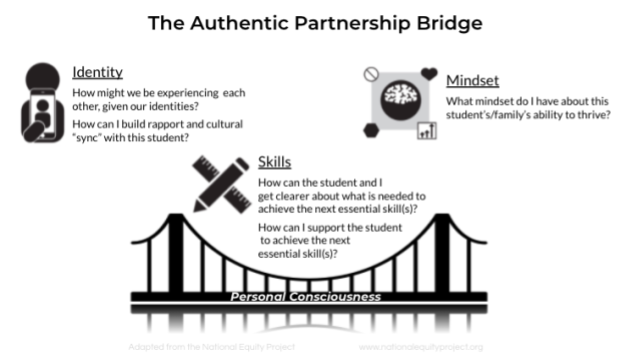
Pathway On the News Link to this section
Getting Ready for Back to School: Pathway Teacher Codion Isom Link to this section
Preparing for Distance Learning: Pathway Teacher Roland Stevens (video location 4:00) Link to this section
This page was last updated on June 13, 2024


